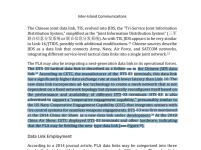While "A shoot, B guide" may sound simple, what India has achieved is far more complex and significant. NetCor1 and NetCor2 are not just basic data link systems; they represent a sophisticated, integrated combat network that connects a wide range of platforms including fighters, AWACS, ground radars, and naval assets. This isn’t just about one aircraft firing and another guiding; it’s about creating a unified battle space where every element, from aircraft to ships to ground units, shares data in real-time, enhancing situational awareness and operational effectiveness. India’s approach allows for cooperative engagement where multiple platforms can coordinate attacks, share targeting information, and execute complex maneuvers without exposing themselves. For example, an IAF aircraft can detect and track a target, share that data instantly with another fighter, which can then launch a missile without ever turning on its radar, preserving its stealth. This level of integration offers significant tactical advantages, enabling the IAF to conduct highly coordinated and precise operations in contested airspace, which is crucial in modern warfare. Moreover, India’s capabilities are not just about reactive measures but proactive strategies that enhance survivability and effectiveness. In high-intensity conflict scenarios, such as potential engagements at the LAC, these systems reduce the risk to high-value assets like AWACS by allowing ground-based crews to assist with real-time data processing, effectively extending the operational range and safety of these assets. This integrated approach ensures that even under heavy attrition, the IAF maintains a cohesive and resilient operational capability.
In essence, India’s military technology is far from rudimentary; it is a highly advanced, integrated system designed to dominate in complex, multi-domain environments, setting it apart from conventional, simple data link approaches.
The ideal is beautiful, but the reality is cruel.
I don't want to splash cold water on you, but you need to sober up. If you want, I can help you do some fundamental analysis, and you can look at the gap between the reality of India and your ideals.
The active equipment of the India army comes from different countries of the world and different eras. In addition to India self-made equipment, there are also equipment from Russia, France, and Israel...............
Equipment from different countries and eras have completely different data communication protocols and data communication interfaces. There is no direct real-time data exchange between them. They can only achieve simple data communication between them, or through a separate communication conversion module to achieve simple tactical data exchange. It is not possible to exchange data in full real-time.
At present, the known military data links are NATO, China, and Russia, but Russia's communication technology capabilities are poor, and the actual data link capabilities are very limited. The only internationally recognized data links suitable for modern and future warfare are NATO (the actual research and development is dominated by the United States) and China.
India's capabilities in communications technology are very limited, and the possibility of developing modern military data links on its own is almost non-existent. And India's current nationalism is rife, and the likelihood of joining NATO and using NATO's data link is low. Even with NATO's datalink, it means that all the equipment in service has to be completely updated, which is a very, very large expense.
Of course, India's friends may object to this statement. Whether it is military or civilian, the underlying logic of communication technology is exactly the same, but there are differences in technical indicators, encryption capabilities, and anti-jamming capabilities. India friends can take a look at how much of India's current civil communication system belongs to India's own technology, and how many core components of the equipment are India its own............. You can check for yourselves and then refute me. Of course, the PPT of the India government and the text slogans of the India media do not need to be issued.
Without the support of advanced military data links, how to achieve real-time data sharing across platforms and services? Without an advanced real-time data link, how can you achieve the vision you described? Link with the Great India Dream?
First try to achieve "A shooting, B guidance" between different types of fighters. For example: LCA, Su 30 MKI, Rafale any two of the three fighters, to achieve "A shooting, B guidance". And then let's look at how the vision will be realized.............
In fact, India is already lagging behind Pakistan in this regard. While India won't admit it, it's true.







